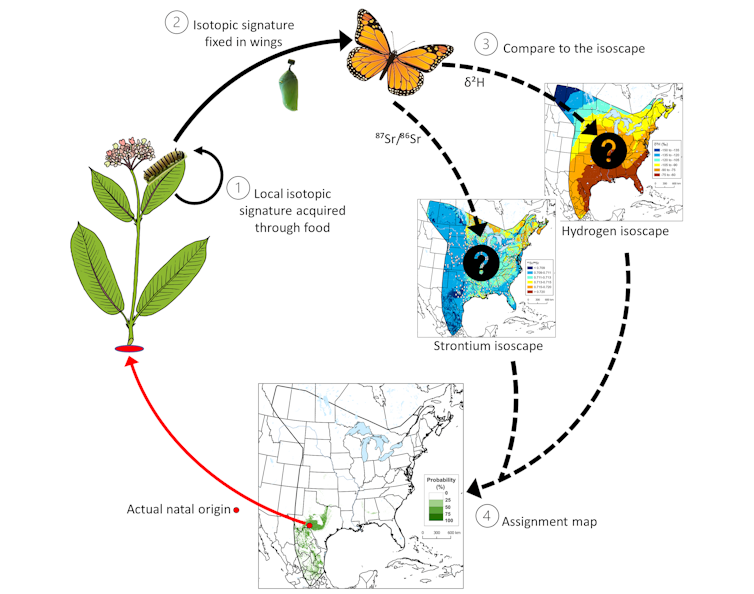Strontium isotopes can map monarch butterfly migrations and help conservation efforts
Author: Megan Reich, PhD candidate, Biology, L’Université d’Ottawa/University of Ottawa

(Shutterstock)
The eastern North American population of monarch butterflies are famous for their annual, multi-generational, round-trip migration from the oyamel fir forests of Central Mexico through the United States to Canada and back. Sadly, the population of monarch butterflies is declining, and the future of the monarch migratory phenomenon is uncertain.
Scientists can study migrations by looking at the chemicals stored within the teeth, bones, tusks and wings of animals. In the case of monarch butterflies, the signature contained in its wings reveals where it was a caterpillar, allowing researchers to trace its natal origin, or birthplace.
Isotopes are atoms of the same element that have different masses because they have a different number of neutrons. For some elements, such as hydrogen and strontium, the proportion of heavy versus light isotopes in the environment changes predictably between locations, giving locations unique isotopic signatures. A map of these local isotopic signatures is called an isoscape.
Isotopes have informed conservation efforts for decades because they are helpful for identifying where an animal has migrated from.
Strontium (Sr) is an alkaline earth metal with four stable isotopes: 84Sr, 86Sr, 87Sr and 88Sr. Strontium isotopes ratios (the ratio of 87Sr to 86Sr) are a new addition to the ecologist’s isotopic toolbox. Strontium isotopes will help ecologists pinpoint the origins of migrating animals more precisely and solve longstanding questions related to the migratory connectivity and migratory patterns of monarch butterflies.
What bodies can reveal
As animals (including humans) feed and drink, they incorporate the local isotopic signature into their bodies. The isotopic signature of animal tissue can then be compared to an isoscape map to find out where the tissue was formed.
For example, the strontium isotope ratio of human teeth can tell you where a person spent their childhood because teeth are formed early in life. Human bones, however, will tell you where they spent the last decade of their life because bone tissue replaces itself every 10 years or so.
Some tissues grow in layers over time, like in tree rings or fish earbones. These layered tissues reveal where an animal was located at different times of its life, as shown with mammoth tusks.

(Megan Reich), Author provided
Why do we need isotope geolocation?
Ideally, we would study animal migration by putting tiny radio transmitters on many individuals and tracking them for a long period of time. However, this approach isn’t practical in many situations.
For example, we cannot use a radio transmitter to find the origin of poached elephant ivory or the home range size of extinct lemur specimens from a museum. But we can use isotopes to learn something about the lives of these deceased animals.
Some animals, like insects, are too small and numerous to be effectively tracked using tagging methods. Although significant advances have been made in recent years, insects are still too small to be tracked with radio transmitters on a large scale. Therefore, isotopes are one of our best tools for answering questions about insect migratory patterns and connectivity. Given the current context of global climate change and population declines, we urgently need to know more about animal migration so that we can conserve migrations for future generations.
The case of monarch butterflies
Hydrogen and carbon isotopes have been used for decades to trace the natal origins of monarch butterflies. These studies have helped guide conservation efforts and inform listing decisions.
For example, isotopes have helped researchers figure out which regions of the United States contribute the most monarchs to the overwintering population. Other studies have shown that some monarchs are opting for a non-migratory lifestyle and have shown that an extreme northwestern migration into Canada came from the Midwest.
Strontium isotope ratios and monarch butterflies
My collaborators and I recently demonstrated how strontium isotopes can be used to study animal migration. We found that strontium isotopes, especially when combined with hydrogen isotopes, can estimate the natal origin of a monarch butterfly to a more precise geographic location — about four times better — than using hydrogen alone.
In our study, we created a strontium isoscape map for the breeding range of the monarch butterfly. This means we now have a ready-to-use tool for estimating the natal origin of monarch butterflies using strontium.
We hope that applying strontium isotopes to both new and archived monarch specimens will advance our understanding of how monarch migration patterns and connectivity have changed over time, and ultimately help guide conservation actions to protect this migratory phenomenon.![]()
This article is republished from The Conversation under a Creative Commons license. Original article.